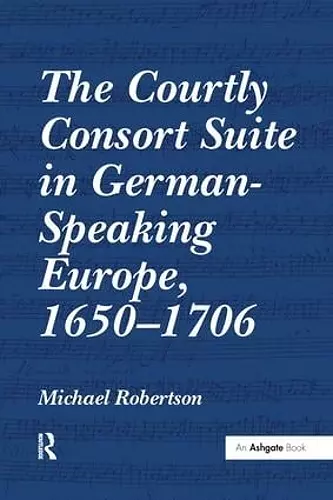The Courtly Consort Suite in German-Speaking Europe, 1650–1706
Format:Paperback
Publisher:Taylor & Francis Ltd
Published:9th Sep '16
Currently unavailable, and unfortunately no date known when it will be back
This paperback is available in another edition too:
- Hardback£160.00(9780754664512)

Dance music at the courts of seventeenth-century Germany is a genre that is still largely unknown. Dr Michael Robertson sets out to redress the balance and study the ensemble dance suites that were played at the German courts between the end of the Thirty Years War and the early years of the eighteenth century. At many German courts during this time, it was fashionable to emulate everything that was French. As part of this process, German musicians visited Paris throughout the second half of the seventeenth century, and brought French courtly music back with them on their return. For the last two decades of the century, this meant the works of Jean-Baptiste Lully, and his music and its influence spread rapidly through the courts of Europe. Extracts from Lully's dramatic stage works were circulated in both published editions and manuscript. These extracts are considered in some detail, especially in terms of their relationship to the suite. The nobility also played their part in this process: French musicians and German players with specialist knowledge were often hired to coach their German colleagues in the art of playing in the French manner, the französischer Art. The book examines the dissemination of dance music, instrumentation and performance practice, and the differences between the French and Italian styles. It also studies the courtly suites before the advent of Lullism and the differences between the suites of court composers and town musicians. With the possible exception of Georg Muffat's two Florilegium collections of suites, much of the dance music of the German Lullists is largely unknown; court composers such as Cousser, Erlebach, Johann Fischer and Johann Caspar Ferdinand Fischer all wrote fine collections of ensemble suites, and these are examined in detail. Examples from these suites, some published for the first time, are given throughout the book in order to demonstrate the music's quality and show that its neglect is completely unjustified.
’No whistle-stop tour of this volume can do justice to its richness of content....I was impressed by both the musical and the musicological acumen of the author. The numerous music examples are well chosen and presented... I came away from reading this book with a knowledge of many things of which I had at best only dimly been aware before. Some of Robertson’s arguments are memorable.’ Michael Talbot, Early Music ' ... [a] thorough study ... worth reading.’ Early Music Review ’... clearly written... meticulously researched, it breaks new ground. ...a valuable contribution to our knowledge of a relatively unfamiliar body of music.’ The Consort ’No whistle-stop tour of this volume can do justice to its richness of content. ... I came away from reading this book with a knowledge of many things of which I had at best only dimly been aware before. ... Readers will perhaps return to this book most often as a starting point for further investigation of the surprisingly many worthy, and sometimes excellent, composers it brings for the first time to our notice.’ Early Music '...[an] important study ... [with] a wealth of valuable information.' Viola da Gamba Society Journal
ISBN: 9781138251489
Dimensions: unknown
Weight: 453g
298 pages